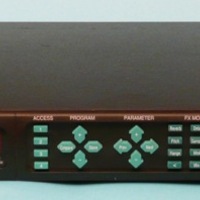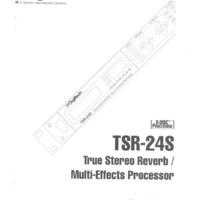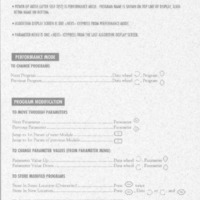DigiTech TSR-24S
Item
Model
DigiTech TSR-24S
Make
DigiTech
Type
Effects Rack
Description
TSR-24 stands for "True Stereo Reverb, 24 bit"The TSR-24 reverb/effects unit was made with two versions: TSR-24 and TSR-24SThe TSR-24S in nothing other than a TSR-24 with the latest firmware (Version 2.00) and 20MHz cycle frequency of the main processor.So EVERY TSR-24 can be upgraded to TSR-24S The "S" version adds many new algorithms, increases the maximum delay time, supports the PPC-200 and PPC-210 upgrade and the main processor runs at 20MHzSpecs
A/D converter: 18-bit, 128x oversampling delta sigma stereo A/D converter.
D/A converter: 18-bit PCM.
Sampling frequency: 48kHz.
Digital signal path: 24-bit.
Internal data path: 48-bit.
FX groups: Reverb, Delay, Chorus, Pitch, Sample, EQ, Flange, Mod, More (noise gates, silencers, duckers, wahs, phase inverter), Mix.
OverviewThe TSR-24S has 128 editable and 112 preset Programs (the manual claims 256 of each), organized in one bank of 240 Programs. You can freely overwrite Programs 1-128; 129-240 are preset. Note that Programs 113-128 are bypassed unless you have the optional PPC-200/210 installed; these show off the capabilities of a double processor-equipped TSR24S. If you have the standard unit only, you can't use them, but you can overwrite them.At the heart of each Program is an Algorithm, a configuration of effects. You can select from 24 factory algorithms (32 with the PPC-200/210 installed), or create up to 32 custom algorithms - sound quality aside, this is the single most attractive and powerful feature of the TSR24S. When creating an algorithm from scratch, you have a choice of 78 effects modules, linkable in any order, and 25 mixer modules: mixer modules (which offer up to 16 inputs and a choice of mono, stereo, and 3-output operation) are needed to patch the effects together. The list of possible effects modules is comprehensive: 10 reverbs, 17 delays, 10 EQs, three samplers, eight choruses and flangers, 10 pitch-shifters, noise reduction, phasers, tremolos, wah-wahs and duckers; there's even a phase inverter and tuning reference.Programming the TSR-24S is, in spite of the manual, relatively simple. The FX module buttons allow you to fly around the system without getting too confused; choose your effect, scroll to a parameter, tweak it, have a listen, and save the result. Simple.As for algorithm creation, Digitech make this easy as well. Firstly, it pays to offline a little work to pen and paper - plan your algorithm, add up the CPU and RAM blocks you'll need, and then go to the TSR-24S. Select any algorithm, and press the Add button. This gives you the option to modify a factory algorithm or create one from scratch. Scroll through the modules and press "Enter" when you reach one you wish to use. When you've made your selections (or run out of Blocks), you patch the effects together. An auto-link function 'plugs' the modules together in the most logical manner, but manually linking modules, with the aid of the excellent new graphic module linking feature, is simply a matter of scrolling through options and confirming your choice. It works like a small-screen version of Apple's MIDI Manager for Macintosh computers.One of the most attractive selling points of the TSR-24S is its ability to be used as two discrete processors. The biggest compromise is that your total of four or five effects modules per algorithm is now split in two. There are three factory 2-channel algorithms, but you can also programme your own; it's possible to create some excellent everyday effects for both channels, but off-the-wall processing is best left to single chains - or to a PPC200/210-equipped TSR24S, which effectively means two TSR-24Ss in one box."Digitech's S-DISC based processors produce some of the cleanest, most complex reverbs available in affordable packages."One other easily overlooked feature that saves money is the built-in chromatic tuner, accessible under the Utility button. This is blissfully easy to use, not to mention accurate. You simply alter an instrument's tuning until the strobing vertical bars at the bottom of the LCD stop moving - the tuner automatically detects which note you're trying to tune. The overall tuning reference can be altered between A = 427 and 453, or set to A-flat, G or G-flat, so if you want to tune to a lower, renaissance reference point, this is the machine for you.It's been said before, but Digitech's S-DISC based (Static/Dynamic Instruction Set Computer) processors produce some of the cleanest, most complex reverbs available in affordable packages. The TSR-24S is no exception: its reverbs offer programmability unavailable at this price elsewhere - as an example, the completely OTT ExaVerb preset has an astonishing 28 editable parameters intended to allow you to convincingly recreate acoustic spaces. The reverbs tend to be bright, but not in the metallic way of some Japanese processors, offering clarity and realism instead. The rest of the effects are equally excellent: delays and samples (up to 5 seconds mono; 2.5 seconds stereo (twice as much with an PPC-200/210 installed)) provide subjectively perfect replications of the input signal; choruses and flangers are rich and exciting (perfect for guitar processing); and the EQ modules add a good deal of creative potential.Noise performance is good, and the NR modules help where the nature of the effect adds unwanted noise. We thought the pitch-shifting modules not quite up to the quality offered by the rest of the effects, which is surprising given Digitech's success with their Vocalist range of harmony processors. Even the Whammy-based effects - derived from the famed digital dive-bomb control found on certain Digitech guitar products - are a little lumpy. However, while we wouldn't use the modules as serious harmony or pitch correction tools - the delays involved and metallic quality are far too obvious - they can be used effectively for guitar processing or sound effects.REAL-TIME MIDI CONTROLAs befits a hi-tech product released in 1995, the TSR24S offers comprehensive real-time MIDI control. Any Continuous Controller can be linked to any TSR-24S parameter; up to 10 Local and 20 Global Controller links are possible. Local links are specific to a particular Program, while Global links are always active - if you assign mod wheel to flanger depth, for instance, that link will work in any program that uses the flanger.To make the link between Controller and parameter, select a parameter, press the MIDI button, and the link is made. Now choose which Controller will do the controlling, its operating range, and that's it.Source: http://www.tube-tester.com/sites/tsr24/tsr24-main.htm
A/D converter: 18-bit, 128x oversampling delta sigma stereo A/D converter.
D/A converter: 18-bit PCM.
Sampling frequency: 48kHz.
Digital signal path: 24-bit.
Internal data path: 48-bit.
FX groups: Reverb, Delay, Chorus, Pitch, Sample, EQ, Flange, Mod, More (noise gates, silencers, duckers, wahs, phase inverter), Mix.
OverviewThe TSR-24S has 128 editable and 112 preset Programs (the manual claims 256 of each), organized in one bank of 240 Programs. You can freely overwrite Programs 1-128; 129-240 are preset. Note that Programs 113-128 are bypassed unless you have the optional PPC-200/210 installed; these show off the capabilities of a double processor-equipped TSR24S. If you have the standard unit only, you can't use them, but you can overwrite them.At the heart of each Program is an Algorithm, a configuration of effects. You can select from 24 factory algorithms (32 with the PPC-200/210 installed), or create up to 32 custom algorithms - sound quality aside, this is the single most attractive and powerful feature of the TSR24S. When creating an algorithm from scratch, you have a choice of 78 effects modules, linkable in any order, and 25 mixer modules: mixer modules (which offer up to 16 inputs and a choice of mono, stereo, and 3-output operation) are needed to patch the effects together. The list of possible effects modules is comprehensive: 10 reverbs, 17 delays, 10 EQs, three samplers, eight choruses and flangers, 10 pitch-shifters, noise reduction, phasers, tremolos, wah-wahs and duckers; there's even a phase inverter and tuning reference.Programming the TSR-24S is, in spite of the manual, relatively simple. The FX module buttons allow you to fly around the system without getting too confused; choose your effect, scroll to a parameter, tweak it, have a listen, and save the result. Simple.As for algorithm creation, Digitech make this easy as well. Firstly, it pays to offline a little work to pen and paper - plan your algorithm, add up the CPU and RAM blocks you'll need, and then go to the TSR-24S. Select any algorithm, and press the Add button. This gives you the option to modify a factory algorithm or create one from scratch. Scroll through the modules and press "Enter" when you reach one you wish to use. When you've made your selections (or run out of Blocks), you patch the effects together. An auto-link function 'plugs' the modules together in the most logical manner, but manually linking modules, with the aid of the excellent new graphic module linking feature, is simply a matter of scrolling through options and confirming your choice. It works like a small-screen version of Apple's MIDI Manager for Macintosh computers.One of the most attractive selling points of the TSR-24S is its ability to be used as two discrete processors. The biggest compromise is that your total of four or five effects modules per algorithm is now split in two. There are three factory 2-channel algorithms, but you can also programme your own; it's possible to create some excellent everyday effects for both channels, but off-the-wall processing is best left to single chains - or to a PPC200/210-equipped TSR24S, which effectively means two TSR-24Ss in one box."Digitech's S-DISC based processors produce some of the cleanest, most complex reverbs available in affordable packages."One other easily overlooked feature that saves money is the built-in chromatic tuner, accessible under the Utility button. This is blissfully easy to use, not to mention accurate. You simply alter an instrument's tuning until the strobing vertical bars at the bottom of the LCD stop moving - the tuner automatically detects which note you're trying to tune. The overall tuning reference can be altered between A = 427 and 453, or set to A-flat, G or G-flat, so if you want to tune to a lower, renaissance reference point, this is the machine for you.It's been said before, but Digitech's S-DISC based (Static/Dynamic Instruction Set Computer) processors produce some of the cleanest, most complex reverbs available in affordable packages. The TSR-24S is no exception: its reverbs offer programmability unavailable at this price elsewhere - as an example, the completely OTT ExaVerb preset has an astonishing 28 editable parameters intended to allow you to convincingly recreate acoustic spaces. The reverbs tend to be bright, but not in the metallic way of some Japanese processors, offering clarity and realism instead. The rest of the effects are equally excellent: delays and samples (up to 5 seconds mono; 2.5 seconds stereo (twice as much with an PPC-200/210 installed)) provide subjectively perfect replications of the input signal; choruses and flangers are rich and exciting (perfect for guitar processing); and the EQ modules add a good deal of creative potential.Noise performance is good, and the NR modules help where the nature of the effect adds unwanted noise. We thought the pitch-shifting modules not quite up to the quality offered by the rest of the effects, which is surprising given Digitech's success with their Vocalist range of harmony processors. Even the Whammy-based effects - derived from the famed digital dive-bomb control found on certain Digitech guitar products - are a little lumpy. However, while we wouldn't use the modules as serious harmony or pitch correction tools - the delays involved and metallic quality are far too obvious - they can be used effectively for guitar processing or sound effects.REAL-TIME MIDI CONTROLAs befits a hi-tech product released in 1995, the TSR24S offers comprehensive real-time MIDI control. Any Continuous Controller can be linked to any TSR-24S parameter; up to 10 Local and 20 Global Controller links are possible. Local links are specific to a particular Program, while Global links are always active - if you assign mod wheel to flanger depth, for instance, that link will work in any program that uses the flanger.To make the link between Controller and parameter, select a parameter, press the MIDI button, and the link is made. Now choose which Controller will do the controlling, its operating range, and that's it.Source: http://www.tube-tester.com/sites/tsr24/tsr24-main.htm
Access
Those who have access to Studio 4
Location
Studio 4 Effects Rack
Relation
DigiTech TSR-24



